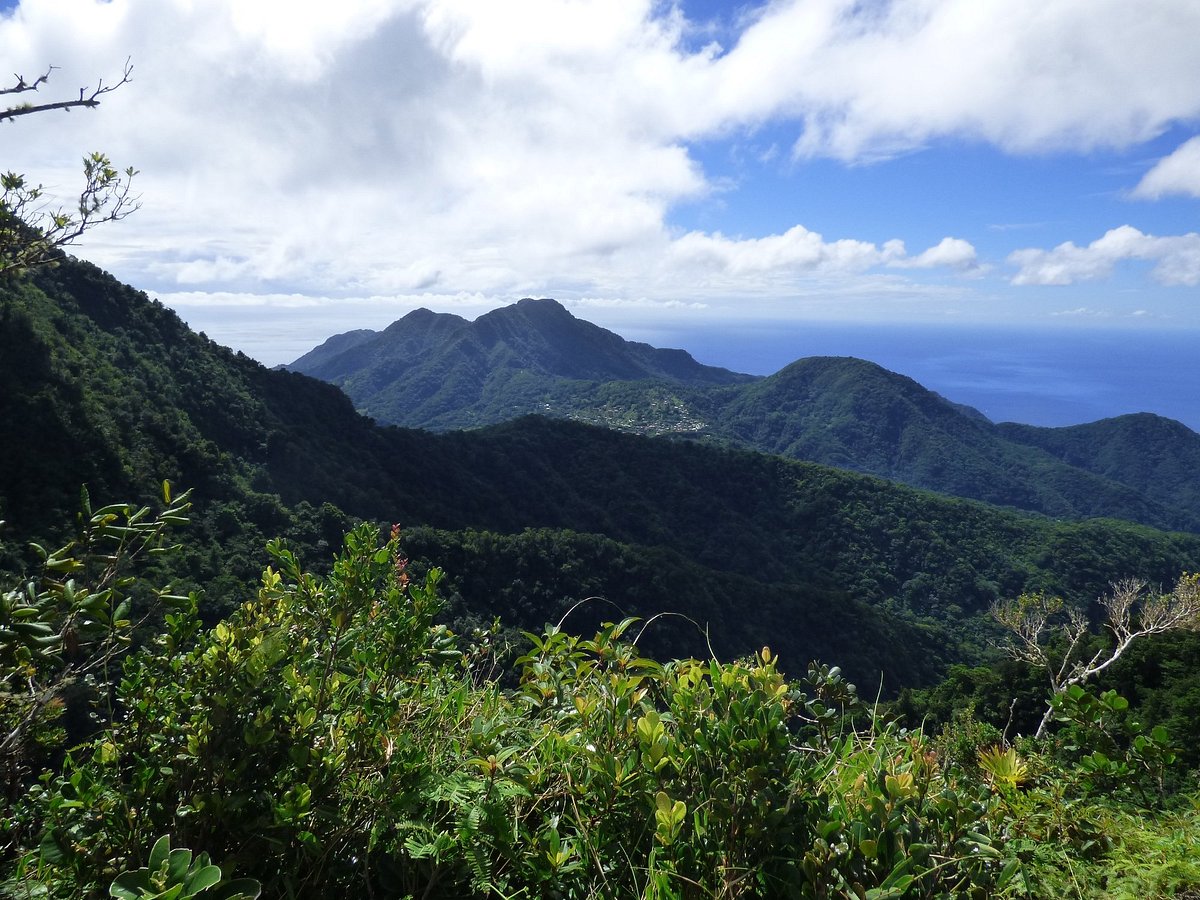Travel
List Of Some Of The Best Hiking Trails In Dominica

Dominica is an eastern Caribbean Lesser Antilles island country. In the north, it borders Guadeloupe and Marie-Galante, and in the south, Martinique. The Commonwealth has accepted the country since 1978. The island is 47 km long and 26 km wide at its widest. Roseau is the capital and port. Dominica’s rugged landscape has captivated generations of nature lovers and allowed them to hike. Volcanoes formed the island.
Dominica has multiple active volcanoes. However, eruptions are rare. Hot springs and fumaroles are other geothermal signs. The southern boiling lake is 700 meters above sea level, and gas pressure raises its waters 1 meter. The island has volcanic and alluvial soils. Numerous rivers are impassable. Mount Diablotins and Mount Trois Pitons, the highest points of a line of high forest-clad mountains running north to south, are broken by a plain drained by the Layou River and popular hiking destinations in Dominica. Dominica has a wonderful climate, especially in chilly December–March.
Winter highs averaging 84–86 degrees Fahrenheit (29–30 degrees Celsius). The dry season is February to May, while the wet season is June to October, when tropical cyclones are most common. Most rain falls in the steep interior. Average annual rainfall at the coast is 60 inches (1,500 mm) to 145 inches (3,700 mm), while the highlands can approach 250 inches (6,350 mm).
Locating hiking trails? You’ve arrived!. Nine volcanoes erupt in Dominica, creating mud pots and the Boiling lake. Hiking in Dominica, climbing and birdwatching on steep tropical rainforest trails, or walking the Caribbean’s first long-distance path, the 115-mile Waitukubuli Trail. Imagine a Caribbean island with top hiking and adventure paths. Is it too wonderful to be true? Ain’t the Caribbean famous for its beaches? On Dominica, nature lovers can hike through an active volcanic caldera to a boiling lake, rappel through deep river gorges, explore vast swaths of pristine tropical rainforest, waterfalls, mountains, and a 200-kilometer national trail. All this on one Caribbean island? Incredible, right?
1. The Boiling lake Trail

Here is the first response to your hiking trail finding query at a vital moment. Dominica’s most popular hike is the Boiling Lake Trail. The full-day trip includes a rainforest, mountain summit, active volcanic crater, and warm-water rivers and cascades. Hiking starts in Titou Gorge (where you can witness a waterfall and enjoy canyoning) and continues into Dominica’s deep jungle.
This beautiful and lonely environment is part of Morne Trois Pitons National Park, a UNESCO World Heritage Site with many volcanoes and natural ecosystems. After climbing and descending Morne Nicholls, Dominica hikers must traverse the magnificent Valley of Desolation, a volcanic landscape of steaming fumaroles, hot boiling mud, and warm water rivers. How better to experience nature than hiking an active volcano in Dominica?
2. The Waitukubuli National Trail

Here’s another Dominica hiking trail, Waitukubuli National Trail. Dominica’s Waitukubuli National Trail (WNT) is unique. A Caribbean island has a 200-kilometer hiking track. Could it be the answer to your hunt for the greatest hiking trails near me? Wow, how cool is that? Do not worry—you won’t have to walk 200 km all at once! Each of the 14 trail segments can be hiked alone. Forest, mountain, river, coastal, agricultural, and settlement are distinct divisions. Many follow historic paths and are firmly established in Dominica’s culture. Some of the more famous (and infamous) portions are: WNT Segment 1: Morne Crabier Trail—a difficult trek to the top gives you stunning views over the Cachacrou isthmus, Soufriere Bay fishing towns, and marine reserve. Even French island Martinique is seen.
WNT Segment 2: The Mountain Village Trail—an agricultural and village trail that borders Morne Anglais and includes Giraudel, Wotten Waven’s hot volcanic spas. WNT Segment 6: The Kalinago Heritage Trail—a full-day tour of the Territory’s settlements and monuments. Since descendants of the Caribbean’s first inhabitants live here, this walk is educational and beautiful. Canoeing, cassava bread, basket weaving, and more are taught to hikers. The climb passes via the Kalinago Barana Aute, a model thatched ‘karbet’ and ‘ajoupa’ village. Horseback Ridge offers breathtaking views of the Territory and the Atlantic coast. WNT Segment 8: Cross-Island Trail The National Trail’s toughest section crosses the island from east to west through primary rainforest, crosses torrent rivers, and climbs a mountainous summit. Look for parrots, agoutis, and possibly wild pigs. Dominica’s most remote and unspoilt environment is a tough but rewarding climb for daring hikers.
3. The Titou Gorge Canyoning Trail

When in Dominica, explore the Titou Gorge Canyoning Trail. How about hiking and canyoning for a fantastic adventure? This is possible with the Titou Gorge Canyoning Trail. Rappelling down a waterfall into the river valley begins the journey. From there, you can follow the river down the mountainside as it bends. Water has sculpted both sides of the canyon walls into beautiful shapes over thousands of years. Tree roots and long liana vines hang from the gorge’s edge.
Being completely hidden under the forest floor is great. Several more waterfalls must be rappelled on the trail. Sometimes there are cascades and deep, gin-clear pools to leap and swim in. Cathedral Canyon, one of Dominica’s most beautiful natural locations, ends the river walk. The canyon and river climb end the excursion. Dominica’s river gorge routes vary in difficulty. No canyoning or rappelling experience? Not an issue. Your experienced canyoning experts will train and equip you before you leave. Anyone with a clue should view Trafalgar Falls, accessible by advanced routes. Stand atop these waterfalls for a rare vista.
4. The Jacko Steps Trail

In the 18th and early 19th centuries, France and Britain sent African slaves to Dominica to work on their sugar and coffee plantations. Captives escaped into Dominica’s densely forested interior mountains. Maroons, led by mysterious chiefs like Jacko, lived in underground encampments. Jacko’s camp sat on a high plateau in Dominica’s heartland, surrounded by cliffs and vegetation. Maroons built a long flight of stone steps on a rock face to connect their camp to the Layou River. After a violent battle, the British militia overran the maroon camp and killed several, including Jacko.
This important heritage trail includes the Jacko Steps and the camp’s location, now Jacko Flats, as well as a walk along the Layou River to a hidden waterfall in a conical canyon. That’s great! Indeed, it is. The world-class Jacko Steps hike loops from Bells village to the trailhead through forests, ridges, and rivers. It’s a symbolic route that intrigues us and reminds us of those who risked their personal and collective freedom.
5. The Morne Anglais Mountain Trail

Morne Diablotin, Dominica’s highest peak, is a great climb, but Morne Anglais, the fifth highest, is my favorite because it’s easier and has great views. From Giraudel’s flower town, the rainforest and montane vegetation make the mountain climb challenging. Along a narrow ridge with perilous slopes, you see soaring raptors and squawking jaco parrots. Hikers can see Dominica’s east, south, and west shores from the summit. A clear day may reveal Guadeloupe and Martinique. The southern Morne Trois Pitons National Park volcanoes and the far-north Morne Diablotin volcano are also visible.
Takeaways:
The name is self-explanatory, as are the dangers. Some people, on the other hand, may fail to consider the risks and succumb to the allure of steam. The boiling is supposed to be caused by heat from a magma chamber beneath the lake. The temperature of the water can reach 194 degrees Fahrenheit. The only way to get there is on foot, which is an exhausting journey.






















